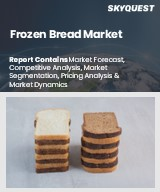
냉동 빵 세계 시장 규모는 2023년에 821억 달러로 평가되었으며, 예측 기간(2025-2032년) 동안 CAGR 6.1%로, 2024년 871억 1,000만 달러에서 2032년에는 1,398억 9,000만 달러로 성장할 전망입니다.
냉동 빵 시장은 바쁜 라이프스타일을 영위하는 도시 소비자들 사이에서 편의식품에 대한 수요가 증가함에 따라 성장의 원동력이 되고 있습니다. 이러한 급격한 성장을 뒷받침하는 것은 저렴한 가격과 적응성을 제공하는 냉동 제품의 인기와 신선도와 품질을 향상시키는 냉동 및 보존 기술의 발전입니다. 빠른 식사 솔루션을 찾는 직장인들의 증가도 이러한 수요를 더욱 촉진하고 있습니다. 예를 들어, 그루포 빔보(Grupo Bimbo)가 2024년에 출시할 새로운 통곡물 냉동 빵 라인은 건강을 중시하는 소비자를 겨냥하고 있습니다. 또한, 카페와 퀵 서비스 레스토랑을 포함한 푸드서비스 부문이 시장 확대에 기여하고 있습니다. 온라인 식료품점의 성장과 콜드체인 물류의 개선으로 제품 접근성이 향상될 것으로 예상됩니다. 그러나 개발도상국의 냉장 비용 상승과 인프라 격차 등의 과제도 남아있지만, 기술 발전과 E-Commerce의 성장으로 이러한 문제는 완화될 것으로 보입니다.
Global Frozen Bread Market size was valued at USD 82.1 billion in 2023 and is poised to grow from USD 87.11 billion in 2024 to USD 139.89 billion by 2032, growing at a CAGR of 6.1% during the forecast period (2025-2032).
The frozen bread market is experiencing significant growth driven by the increasing demand for convenience foods among urban consumers with busy lifestyles. This surge is supported by the popularity of frozen products, which offer affordability and adaptability, as well as advancements in freezing and preservation technologies that enhance freshness and quality. The rise of working professionals seeking quick meal solutions further fuels this demand. For instance, Grupo Bimbo's 2024 introduction of a new line of frozen whole-grain bread targets health-conscious consumers. Additionally, the foodservice sector, including cafes and quick-service restaurants, is contributing to market expansion. The growth of online grocery stores and improved cold chain logistics are expected to enhance product accessibility. However, challenges like high refrigeration costs and infrastructure disparities in developing regions remain, though technological advancements and e-commerce growth are likely to mitigate these issues.
Top-down and bottom-up approaches were used to estimate and validate the size of the Global Frozen Bread market and to estimate the size of various other dependent submarkets. The research methodology used to estimate the market size includes the following details: The key players in the market were identified through secondary research, and their market shares in the respective regions were determined through primary and secondary research. This entire procedure includes the study of the annual and financial reports of the top market players and extensive interviews for key insights from industry leaders such as CEOs, VPs, directors, and marketing executives. All percentage shares split, and breakdowns were determined using secondary sources and verified through Primary sources. All possible parameters that affect the markets covered in this research study have been accounted for, viewed in extensive detail, verified through primary research, and analyzed to get the final quantitative and qualitative data.
Global Frozen Bread Market Segments Analysis
Global Frozen Bread Market is segmented by Product Type, Product Format, Distribution Channel, Storage and Shelf Life, End user and region. Based on Product Type, the market is segmented into White Bread, Whole Wheat Bread, Multigrain Bread, Rye, Sourdough and Gluten-Free Bread. Based on Product Format, the market is segmented into Loaves, Rolls, Baguettes, Ciabatta and Croissants. Based on Distribution Channel, the market is segmented into Retail Channels, Food Service and Online Retailers. Based on Storage and Shelf Life, the market is segmented into Short-term (up to 3 months) and Medium-term (3 to 6 months). Based on End user, the market is segmented into Household Consumption and Commercial Use. Based on region, the market is segmented into North America, Europe, Asia Pacific, Latin America and Middle East & Africa.
Driver of the Global Frozen Bread Market
The Global Frozen Bread market is experiencing a notable surge in demand for gluten-free, whole grain, and preservative-free options, primarily fueled by a rise in health awareness and various dietary restrictions. This trend is particularly evident in North America and Europe, where consumers are increasingly prioritizing transparency regarding ingredient sourcing, nutritional quality, and allergen considerations. As individuals seek healthier and more wholesome alternatives, manufacturers are responding by expanding their offerings to accommodate these preferences, thus contributing to the overall growth and diversification of the frozen bread market in these regions and beyond.
Restraints in the Global Frozen Bread Market
The expansion of the Global Frozen Bread market faces significant challenges due to the need for investments in transportation, temperature-controlled retail settings, and refrigerated storage facilities. These requirements are particularly limiting in underdeveloped areas, where such infrastructure is often lacking or too costly to implement. Consequently, the operational expenses increase for manufacturers targeting rural or low-income markets, ultimately hindering their ability to capture a larger market share. This situation underscores the difficulty in broadening access to frozen bread products in these regions, as the necessary investments can be prohibitively high, stifling overall market growth prospects.
Market Trends of the Global Frozen Bread Market
The Global Frozen Bread market is experiencing a notable trend towards the integration of AI-powered production systems, particularly in North America and Europe. As of early 2024, leading manufacturers are adopting these advanced technologies to enhance quality control through real-time monitoring of key production variables such as baking precision and dough consistency. This trend not only streamlines operational processes and reduces errors but also strengthens market penetration by improving batch consistency and production credibility. Consequently, these innovations are driving a transformation in the frozen bread sector, aligning with consumer demand for higher quality and more reliable products.